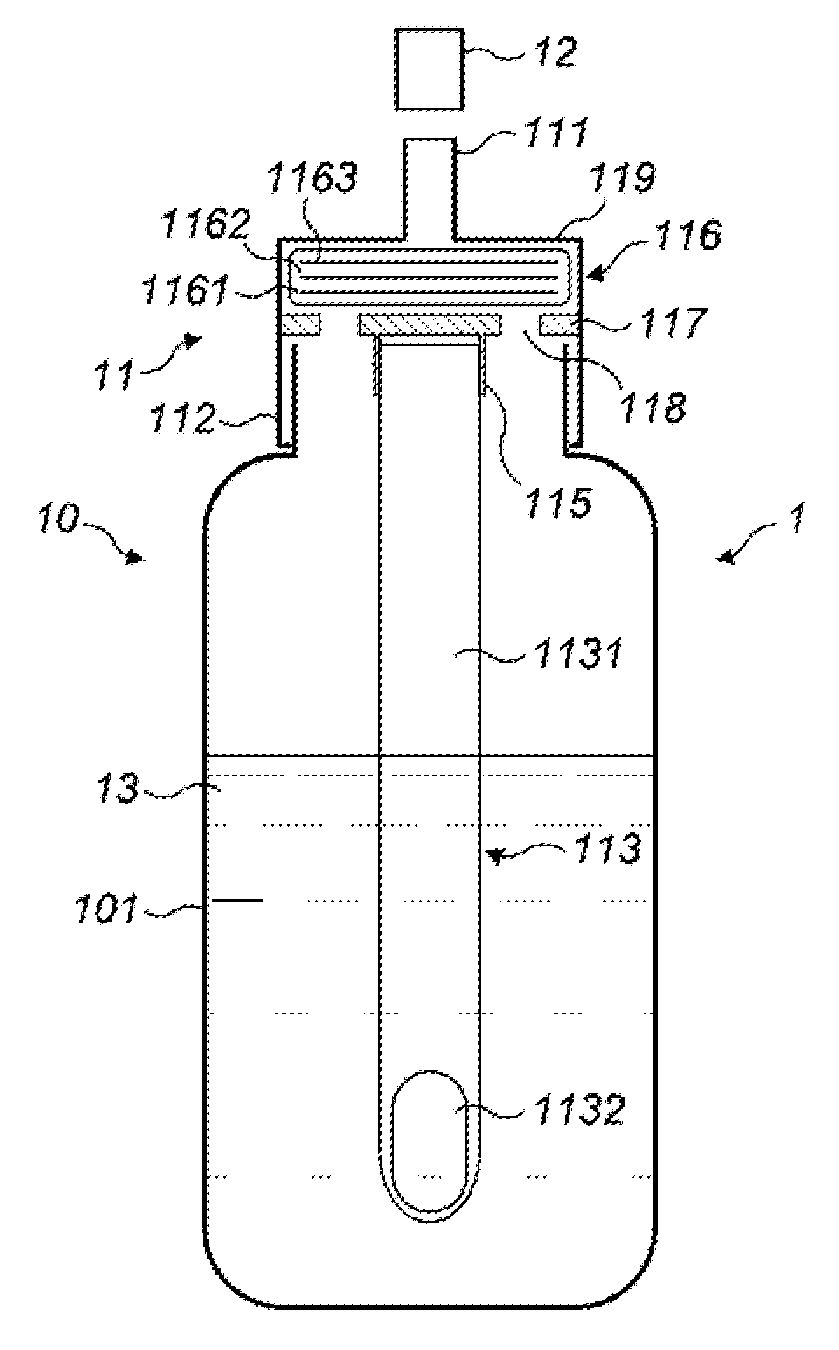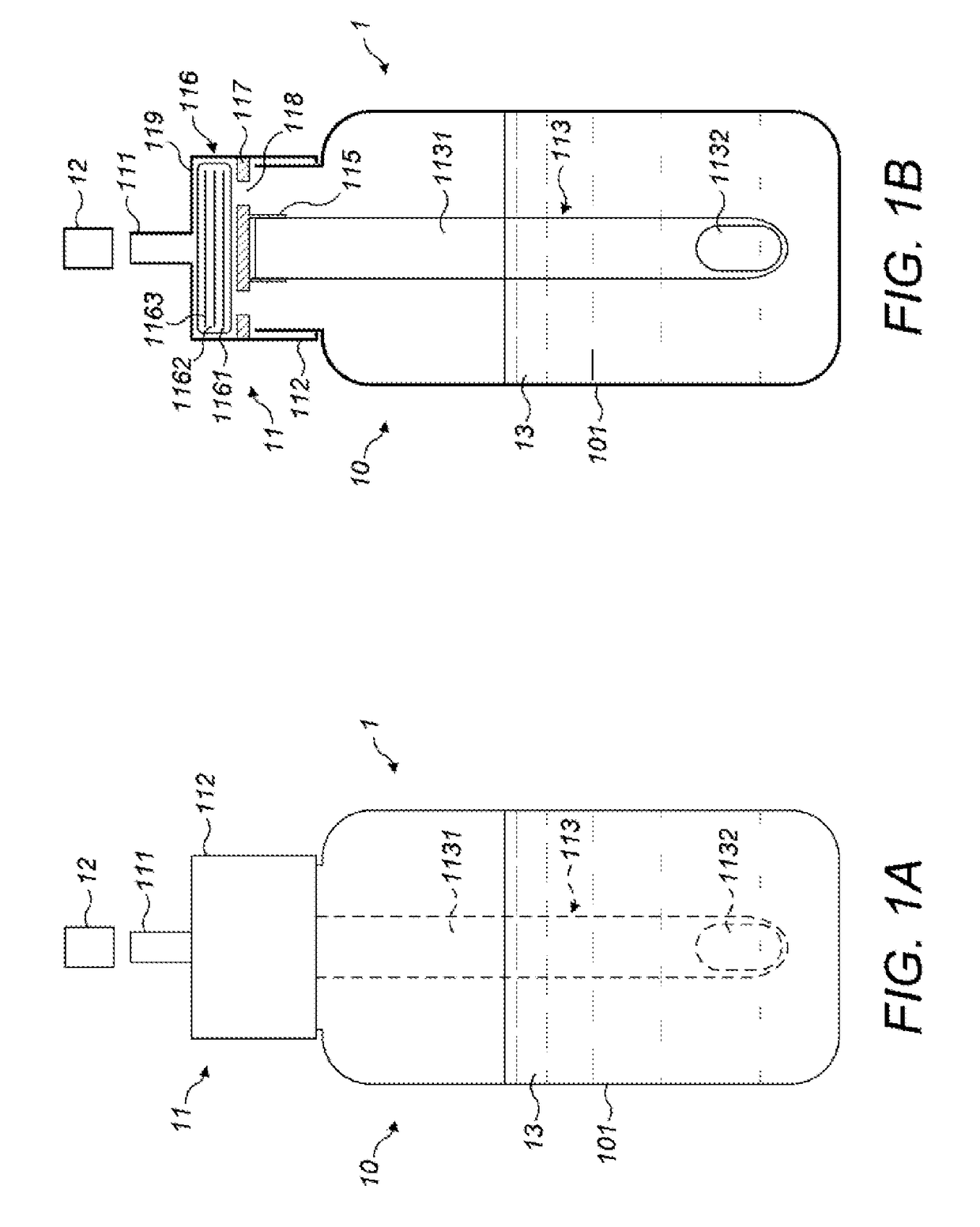Device for Obtaining Biological Material and/or Biological Information from a Sample with a Heterogeneous Matrix
a heterogeneous matrix and biological material technology, applied in the direction of biochemistry apparatus, biochemistry apparatus and processes, devices for withdrawing samples, etc., to achieve the effect of efficient mixing and improved device maintenan
- Summary
- Abstract
- Description
- Claims
- Application Information
AI Technical Summary
Benefits of technology
Problems solved by technology
Method used
Image
Examples
example 1
of a Device According to the Invention
[0275]For the purposes of example 1, the device for obtaining biological material and / or biological information from a sample with a heterogeneous matrix is assembled in the following way:[0276]inserting the first filter 1161 (Filtrona reference: BNW440148) into the central part of the central element 31″ of the stopper 31,[0277]inserting a second filter 1162 (Pall Pad reference: 66025) in superimposition with respect to the first filter 1161,[0278]putting in place the pouring spout 41′ by elastic interlocking of the male clip-fastening systems 427 and 428 and the female clip-fastening systems (grooves hollowed out in the internal side wall 329 of the central element 31″),[0279]clip-fastening the calibrated sampling means 313, having a calibrated hollow part 3132 (volume: 300 μl), in the opening 315 of the central element 31″,[0280]adding 30 glass beads having a diameter of 3 mm to the container 10,[0281]adding 5 ml of suspending solution (in th...
example 2
or Obtaining Biological Material and / or Biological Information Using the Device of Example 1
[0283]The protocol for obtaining biological material and / or biological information from a sample with a heterogeneous matrix according to the present invention, using the device described in example 1, comprises the following steps:
[0284]1) Taking the Sample
[0285]More specifically, the user firstly opens the pot containing the stools to be analyzed, and takes a sample using the calibrated sampling means 313, such that the calibrated hollow part 3132 of the calibrated sampling means 313 is filled with the sample of interest. In order to allow optimal calibration, the calibrated sampling means 313 is then “scraped” on the lip of the abovementioned pot in order to remove the possible surplus of salts present on the calibrated sampling means 313 and / or overflowing the calibrated hollow part 3132.
[0286]2) Suspending the Sample
[0287]Secondly, the user introduces the calibrated sampling means 313 in...
example 4
inearity of Detection of the Nucleic Acids of Various Types of Microorganisms Using the Process for Analyzing Biological Information According to the Invention
[0297]In order to verify the efficiency of the process for analyzing biological information (in the case in point DNA) from a sample with a heterogeneous matrix, which is the subject of the present invention, the following three types of microorganisms were inoculated into the suspending solution contained in the device according to the invention:[0298]carbapenem-resistant Klebsiella pneumoniae (KPC),[0299]methicillin-resistant Staphylococcus aureus (MRSA),[0300]Schizosaccharomyces pombe (S. pombe).
[0301]These three types of microorganisms were chosen according to their size and their characteristics, KPC being a Gram-negative bacillus 5 μm long, resistant to carbapenems, MRSA being a Gram-positive coccus 1 μm in diameter, resistant to methicillin, and S. pombe being a yeast 10 μm long and cylindrical in shape.
[0302]The inocul...
PUM
| Property | Measurement | Unit |
|---|---|---|
| size | aaaaa | aaaaa |
| size | aaaaa | aaaaa |
| size | aaaaa | aaaaa |
Abstract
Description
Claims
Application Information
 Login to View More
Login to View More - R&D
- Intellectual Property
- Life Sciences
- Materials
- Tech Scout
- Unparalleled Data Quality
- Higher Quality Content
- 60% Fewer Hallucinations
Browse by: Latest US Patents, China's latest patents, Technical Efficacy Thesaurus, Application Domain, Technology Topic, Popular Technical Reports.
© 2025 PatSnap. All rights reserved.Legal|Privacy policy|Modern Slavery Act Transparency Statement|Sitemap|About US| Contact US: help@patsnap.com



